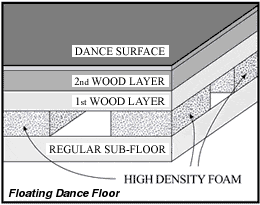|
Four Things Every Parent Should Know Before Choosing a Dance Studio
If most dance studios seem to have qualified, friendly teachers, experience teaching children and a big show at the end of the year, aren't they all pretty much the same? Does it really matter which place you decide to enroll at? Yes. There are four main things that can make a huge difference in the quality of instruction your child receives, the amount of extra work and hassles the parents must deal with and the overall enjoyment and satisfaction of being involved with a dance program.
1. What type of dance floor is used?

Dance is a very physical activity that requires a lot of jumping, which can put stress on bones and joints. Most dance footwear does not provide any cushioning or support, so the shock of dance movement can place a lot of pressure on the knees and back of a dancer. The best way to prevent against potential injury is by choosing a studio with a professional "floating floor". A floating floor is a dance floor that rests on a system of high-density foam, to absorb the shock of jumping. A high-density foam base is superior to a "sprung" floor, which usually consists of a wood structure built on the regular floor.
The top layer of the dance floor is also an important factor. A vinyl composite "Marley" floor is accepted worldwide as the best surface layer for recreational to professional dance. Facilities such as the Royal Winnipeg Ballet, the Royal Academy of Dance in London, England, and River dance - the Touring Show, all use Marley floors as their dance surface. A Marley floor allows dancers to slide, with a degree of controlled slip, but is not slippery so there is less risk of slips and falls. Very few studios use professional Marley floors because of the expense involved, and usually opt for a regular floor tile for a studio floor.
2. What is the size of the class?
If the dance class has fewer students in it each child will receive more personalized attention, learn more and have more fun. With younger students it is easier for a teacher to maintain control over the class and make sure each student understands the concepts and instructions. Our smaller class sizes make sure that no fundamental concepts are being missed. A smaller class size also allows our teachers to ensure that students are not developing bad habits or improper technique.
Our studio limits all of our classes (ages 6 and up) to a maximum of just 12 students per class. With our preschool classes (ages 3 - 5) we limit all of our classes to 8 or 9 students.
3. What are the "extras" required for the year end show?
Most studios put on a year end show in a professional theatre. Students that perform in the show must have a costume for their dance number. Some studios may require parents to sew their child's costumes, or the parents must find their own seamstress to do the sewing. This can be inconvenient and frustrating for parents who are busy or can't sew. Most studios also require parents to purchase tickets for the recital performance night.
Our studio uses our own professional seamstress to sew and alter the costumes, so parents do not have to worry about any costume hassles. Our studio also gives each family one free ticket for our year-end show.
4. Can I get immediate assistance and customer service?
In many studios the teacher or the studio owner conducts classes and does the administration. By trying to do two jobs at once, the class may suffer as the teacher has to use class time for customer service issues, or the studio may have no customer service available if the teacher is in a class. To have a good experience it is important to choose a studio that can assist you with details like costumes or schedules, even if a teacher is occupied in class. Our studio has office staff on hand during all regular class times, so you can get immediate assistance.
|









